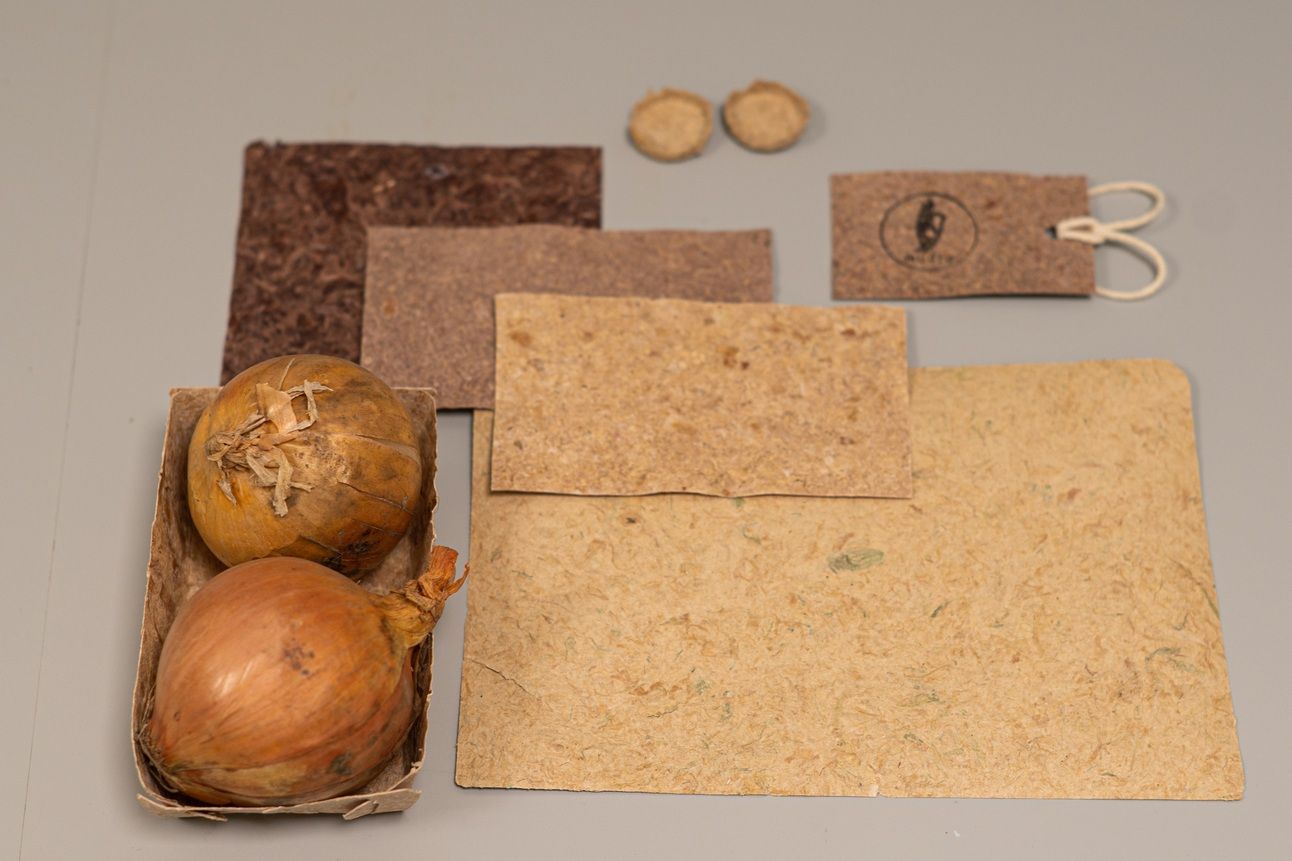- The BioDesign Newsletter
- Posts
- Could Cross-Industry Biomaterial Partnerships Outpace Single-Sector Innovation?
Could Cross-Industry Biomaterial Partnerships Outpace Single-Sector Innovation?
How diversified platform strategies will improve commercial viability beyond single-application biomaterials
Patrick McDowell pioneers triple-material collaborations across luxury and commercial markets
Colorifix's $18M round enables biotech dyeing democratisation beyond exclusive partnerships
Hoxton Farms and Spiber expand biomaterials into food, furniture, and pharmaceutical applications
Circulose's rapid recovery demonstrates a multi-sector validation model

Issue #049
The biomaterials industry is undergoing a fundamental strategic shift. While early-stage companies historically focused on perfecting single applications within specific sectors, the most successful players are now adopting diversified platform approaches that span multiple industries. This week's developments demonstrate why cross-sector strategies are not just accelerating commercialisation—they're becoming essential for survival.
From Patrick McDowell's simultaneous partnerships across three distinct material technologies to Hoxton Farms' expansion from food into pharmaceuticals and cosmetics, the pattern is clear: companies that can serve multiple industries are securing more investment, achieving faster scale, and building more resilient business models than their single-sector counterparts.
The Multi-Sector Design: Patrick McDowell's Platform Approach
Patrick McDowell's recent collaborations reveal how forward-thinking designers are becoming commercial testing grounds for cross-industry material applications. Rather than focusing on single partnerships, they're orchestrating a diversified portfolio that validates biomaterial performance across luxury, commercial, and international manufacturing contexts.
Their Sparxell partnership demonstrates this platform thinking in action. Beyond creating a couture piece featuring dual expressions of structural colour technology—sophisticated matte and brilliant shimmer effects achieved through physics rather than synthetic additives—McDowell is simultaneously launching a commercially accessible shirt dress. This dual-market approach proves the material can perform across price points and production scales, essential validation for broader industry adoption.
The Circ collaboration, featuring Munroe Bergdorf in a custom design using Circ Lyocell (incorporating 40% reclaimed textile waste), extends this validation into the circular materials space. By demonstrating that post-consumer content can achieve luxury aesthetics, McDowell is essentially providing proof-of-concept for mass market applications.
 Gown Patrick McDowell x Sparxell |  Custom Patrick McDowell x Circ Lyocell gown |
Most strategically, their Circulose partnership operates as an international manufacturing laboratory. Working with AGI Denim (Pakistan), KIPAS Textiles (Turkey), Dongheng Textile (China), and Pratibha Syntex (India), McDowell is testing how fully recycled textile material performs across diverse production environments, regulatory contexts, and cultural design requirements. Each manufacturing partner contributes two pieces, creating a global dataset of material performance that serves the broader industry.
McDowell's approach isn't just about design innovation—it's about creating a commercial validation platform that de-risks biomaterial adoption for manufacturers, retailers, and consumers across multiple markets simultaneously.
Circulose's Multi-Sector Validation Model
McDowell isn’t the only one to secure a partnership with Circulose; the H&M group and MANGO have also thrown their weight behind the textiles-recycling company. Circulose's remarkable transformation from Renewcell's bankruptcy to securing these major partnerships demonstrates how diversified validation strategies can accelerate commercial recovery.
The H&M Group partnership provides large-scale validation across multiple brands (H&M, Cos, Weekday, Arket), proving the material can meet diverse aesthetic and performance requirements within a single retail ecosystem. This breadth of application within one partnership reduces risk while providing extensive market data.
MANGO's positioning as Circulose's premier 'Scaling Partner' adds fast-fashion validation to the luxury applications proven through McDowell's work. This combination of market segments provides comprehensive commercial proof that supports expansion into other sectors, potentially including home textiles, automotive applications, or technical fabrics.
Rather than rebuilding through a single-sector focus, Circulose is leveraging multi-sector validation to demonstrate platform viability— a strategy that appears to be accelerating its commercial recovery.
From Exclusive to Accessible: Colorifix's Platform Improves Accessibility
Colorifix's $18M funding round, led by Inter IKEA Group, exemplifies how biomaterial companies are evolving from exclusive partnerships to platform accessibility. Their microbial dyeing technology—replacing petrochemicals with engineered microorganisms—was previously limited to strategic partners, constraining both revenue and market validation opportunities.
The launch of Colorifix Studio fundamentally changes this dynamic. By making their technology available in flexible quantities and expanded colour ranges, Colorifix is transitioning from a single-client service model to a platform that can serve fashion, home goods, automotive, and potentially medical textiles simultaneously.
Colorifix founders have said that their process could be used in applications beyond textiles. Inter IKEA likely also sees this potential and has already considered how it could be used in their entire product ecosystem, from furniture upholstery to home textiles to packaging materials. This cross-category thinking enables Colorifix to scale faster while providing IKEA with integrated sustainability solutions across multiple product lines.
Multi-Biomaterial Integration: The Korvaa Shoe as Cross-Technology Platform
Modern Synthesis's collaboration with Ecovative and Ourobio on the Korvaa Shoe represents the logical evolution of platform thinking: rather than perfecting single materials for a single product, these companies are proving that biomaterial integration can create superior products across multiple applications.
The shoe's material architecture—bacterial nanocellulose uppers, 3D-printed PHA midsoles, and seven-day mycelium soles—demonstrates technical capabilities that extend far beyond footwear. Bacterial nanocellulose could serve medical applications, automotive interiors, or electronics casings. PHA 3D printing has applications in packaging, medical devices, and consumer goods. Rapid mycelium growth could revolutionise furniture, construction materials, and packaging.
By proving these materials work together in a demanding application like footwear, the consortium is essentially validating platform technologies for dozens of potential industries. This integrated approach reduces R&D costs per application while accelerating commercial readiness across sectors.
Beyond Textiles: Platform Technologies Diversify Revenue Streams
The most compelling evidence for cross-industry strategies comes from companies explicitly building platform technologies for multiple sectors.
Hoxton Farms' partnership with Mitsui Chemicals Group illustrates this perfectly. While starting with Hoxton Fat for food applications, they're explicitly positioning their biomanufacturing platform for future applications such as cosmetics, pharmaceuticals and sustainable materials. By partnering Mitsui's technical expertise with Hoxton’s novel bioreactors, they're creating production capabilities that can serve multiple high-value industries simultaneously.
This platform approach provides critical advantages: R&D costs are spread across sectors, reduced dependence on any single industry's adoption timeline, and technical synergies where requirements from one application improve performance in others. Food-grade safety standards enhance pharmaceutical applications; cosmetic aesthetic requirements improve consumer materials; and pharmaceutical precision benefits food ingredients.
Spiber's expansion into furniture through Karimoku Furniture's sofa upholstered in Brewed Protein™ fiber demonstrates similar platform thinking. Having proven their material in textile applications, they're now validating performance in durability-demanding furniture applications. Success here opens automotive, construction, and industrial applications, each representing substantial revenue opportunities.
This cross-sector validation strategy mirrors Modern Meadow's approach with Mercedes-Benz, where their INNOVERA™ technology was integrated into the CONCEPT AMG GT XX as a bio-design leather alternative. By combining recycled AMG GT3 racing car tires with plant-based proteins and biopolymers, Modern Meadow demonstrated how biomaterials can meet automotive performance standards while offering design flexibility equivalent to traditional leather. Their development partnership with Mercedes-Benz explicitly targets series production applications, positioning INNOVERA™ as a platform technology for next-generation automotive interiors across the luxury vehicle segment.
The Platform Advantage: Why Diversification Drives Commercial Success
These developments reveal why cross-industry platform strategies are outperforming single-sector approaches:
Risk Mitigation: Multiple revenue streams reduce vulnerability to any single industry's adoption cycles, regulatory changes, or market disruptions. If fashion adoption slows, furniture or automotive applications can provide continued growth.
Accelerated ROI: R&D investments generate returns across multiple sectors rather than depending on single-application success. Development costs for bacterial nanocellulose serve medical, automotive, and consumer applications simultaneously.
Technical Synergies: Requirements from different industries drive faster innovation. Automotive durability standards improve textile performance; medical safety requirements enhance food applications; and fashion aesthetics improve furniture materials.
Investment Attractiveness: Platform technologies offer larger addressable markets and more predictable scaling paths than single-application companies, making them more attractive to investors and strategic partners.
Market Validation: Success in one sector provides proof-of-concept for adjacent applications. Luxury fashion validation supports mass market adoption; food safety certification enhances pharmaceutical applications.
The European Commission's withdrawal of the Green Claims Directive makes these proactive platform strategies even more significant. Without regulatory pressure driving adoption, companies must build commercial viability through market demand across multiple sectors rather than compliance requirements.
Strategic Implications for Industry Stakeholders
For biomaterial companies, these examples demonstrate that platform thinking isn't just about market expansion—it's about fundamental commercial sustainability. Single-sector strategies may achieve technical excellence but struggle with commercial viability due to concentrated adoption risk.
For traditional manufacturers and retailers, early partnerships with platform-focused biomaterial companies provide competitive advantages across multiple product lines rather than isolated improvements. Inter IKEA's investment in Colorifix potentially transforms their entire textile supply chain, not just specific products.
For investors, platform strategies offer more predictable scaling paths and larger addressable markets than single-application investments. The ability to pivot between sectors provides resilience that single-focus companies cannot match.
The companies leading this transition understand that material innovation requires ecosystem thinking across industries, not isolated development within sectors. Success depends on building technologies that can serve multiple markets simultaneously, creating commercial sustainability through diversification rather than depending on single-sector adoption.
Our latest Behind the Breakthroughs piece is now out!

One of our writers, Aastha Kothari, sat down with Marie Rapin to discuss HUID’s Mission to rethink packaging
With the growing urgency of the global plastic crisis, it's clear that swapping petroleum-based plastics for compostable alternatives isn’t enough.
Read the full piece here »»»
Until next time,
Ariyana & the House of BioDesign Team

The BioDesign Newsletter is an independent publication.
© 2025 House of BioDesign Limited. All rights reserved.
Reply